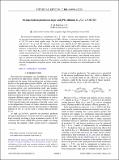Strange hadron production in pp and p Pb collisions at √ s N N = 5.02 TeV
Author(s)
The CMS Collaboration
DownloadPublished version (1.348Mb)
Publisher with Creative Commons License
Publisher with Creative Commons License
Creative Commons Attribution
Terms of use
Metadata
Show full item recordAbstract
© 2020 CERN. The transverse momentum (pT) distributions of Λ, Ξ-, and ω- baryons, their antiparticles, and KS0 mesons are measured in proton-proton (pp) and proton-lead (pPb) collisions at a nucleon-nucleon center-of-mass energy of 5.02 TeV over a broad rapidity range. The data, corresponding to integrated luminosities of 40.2 nb-1 and 15.6 μb-1 for pp and pPb collisions, respectively, were collected by the CMS experiment. The nuclear modification factor RpPb, which is defined as the ratio of the particle yield in pPb collisions and a scaled pp reference, is measured for each particle. A strong dependence on particle species is observed in the pT range from 2 to 7 GeV, where RpPb for KS0 is consistent with unity, while an enhancement ordered by strangeness content and/or particle mass is observed for the three baryons. In pPb collisions, the strange hadron production is asymmetric about the nucleon-nucleon center-of-mass rapidity. Enhancements, which depend on the particle type, are observed in the direction of the Pb beam. The results are compared with predictions from epos lhc, which includes parametrized radial flow. The model is in qualitative agreement with the RpPb data, but fails to describe the dependence on particle species in the yield asymmetries measured away from midrapidity in pPb collisions.
Date issued
2020Department
Massachusetts Institute of Technology. Department of Physics; Massachusetts Institute of Technology. Laboratory for Nuclear ScienceJournal
Physical Review C
Publisher
American Physical Society (APS)